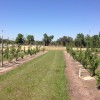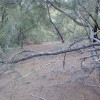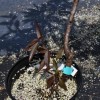 Subtropical peach production includes many practices, such as site selection, orchard design, and disease, weed, and insect management through to harvest. Florida’s subtropical climate allows growers to harvest their crops early, but it creates challenges for the long postharvest growing season. This 14-page fact sheet covers the breadth of topics related to subtropical peach production, including a monthly timeline of recommended practices. Written by M. Olmstead, J. Chaparro, J. G. Williamson, R. Rouse, R. Mizell, P. Harmon, and J. Ferguson, and published by the UF Department of Horticultural Sciences, August 2013.
Subtropical peach production includes many practices, such as site selection, orchard design, and disease, weed, and insect management through to harvest. Florida’s subtropical climate allows growers to harvest their crops early, but it creates challenges for the long postharvest growing season. This 14-page fact sheet covers the breadth of topics related to subtropical peach production, including a monthly timeline of recommended practices. Written by M. Olmstead, J. Chaparro, J. G. Williamson, R. Rouse, R. Mizell, P. Harmon, and J. Ferguson, and published by the UF Department of Horticultural Sciences, August 2013.
http://edis.ifas.ufl.edu/hs348
Tag: J. Ferguson
Florida Peach and Nectarine Varieties
 The University of Florida has developed high-quality, low-chilling, early-maturing peach and nectarine cultivars that can be grown from the panhandle of Florida to as far south as Immokalee. Low-chilling cultivars can grow and produce fruit under Florida conditions that are much warmer in winter than in northern states. Furthermore, ripening of these cultivars during April and May ensures an early spring market window for tree-ripe fresh fruit in Florida before peaches and nectarines from other southeastern states and California come to market. Both commercial and dooryard recommended varieties span the growing season. This 8-page fact sheet was written by Mercy Olmstead, Jose Chaparro, Pete Andersen, Jeff Williamson, and James Ferguson, and published by the UF Department of Horticultural Sciences, May 2013.
The University of Florida has developed high-quality, low-chilling, early-maturing peach and nectarine cultivars that can be grown from the panhandle of Florida to as far south as Immokalee. Low-chilling cultivars can grow and produce fruit under Florida conditions that are much warmer in winter than in northern states. Furthermore, ripening of these cultivars during April and May ensures an early spring market window for tree-ripe fresh fruit in Florida before peaches and nectarines from other southeastern states and California come to market. Both commercial and dooryard recommended varieties span the growing season. This 8-page fact sheet was written by Mercy Olmstead, Jose Chaparro, Pete Andersen, Jeff Williamson, and James Ferguson, and published by the UF Department of Horticultural Sciences, May 2013.
http://edis.ifas.ufl.edu/mg374
Allelopathy: How Plants Suppress Other Plants (HS944/HS186)
 Allelopathy refers to the beneficial or harmful effects of one plant on another plant, both crop and weed species, from the release of biochemicals, known as allelochemicals, from plant parts by leaching, root exudation, volatilization, residue decomposition, and other processes in both natural and agricultural systems. This 5-page fact sheet introduces the concept of allelopathy and mentions potential applications as an alternative weed management strategy. Written by James J. Ferguson, Bala Rathinasabapathi, and Carlene A. Chase, and published by the UF Department of Horticultural Sciences, March 2013.
Allelopathy refers to the beneficial or harmful effects of one plant on another plant, both crop and weed species, from the release of biochemicals, known as allelochemicals, from plant parts by leaching, root exudation, volatilization, residue decomposition, and other processes in both natural and agricultural systems. This 5-page fact sheet introduces the concept of allelopathy and mentions potential applications as an alternative weed management strategy. Written by James J. Ferguson, Bala Rathinasabapathi, and Carlene A. Chase, and published by the UF Department of Horticultural Sciences, March 2013.
http://edis.ifas.ufl.edu/hs186
Rootstocks for Florida Stone Fruit (HS1110/HS366)
 Rootstocks have been used in many tree fruit systems to provide growth advantages or pest or disease resistance without affecting productivity and fruit quality. In Florida, stone fruit are grown on rootstocks that specifically provide pest resistance to the peach root-knot nematode. Although several root-knot nematode-resistant rootstocks are available for stone fruit grown in other locations and climates, ‘Flordaguard’ peach rootstock is currently recommended for stone fruit production in Florida. This 5-page fact sheet was written by M. Olmstead, J. Chaparro, and J. Ferguson, and published by the UF Department of Horticultural Sciences, November 2012.
Rootstocks have been used in many tree fruit systems to provide growth advantages or pest or disease resistance without affecting productivity and fruit quality. In Florida, stone fruit are grown on rootstocks that specifically provide pest resistance to the peach root-knot nematode. Although several root-knot nematode-resistant rootstocks are available for stone fruit grown in other locations and climates, ‘Flordaguard’ peach rootstock is currently recommended for stone fruit production in Florida. This 5-page fact sheet was written by M. Olmstead, J. Chaparro, and J. Ferguson, and published by the UF Department of Horticultural Sciences, November 2012.
http://edis.ifas.ufl.edu/hs366